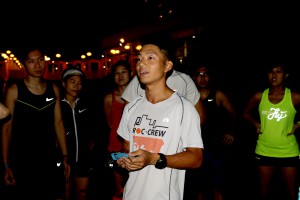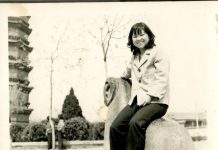
In addition to promoting a healthier lifestyle, some new running groups hope to convey a social message to runners. ROC.Crew was founded in 2014. It takes runners through the streets to explore different communities. The crew stops at landmarks with historical value or where interesting incidents took place, such as Pound Lane in Sheung Wan – where stray animals were kept in the 19th century – Tsim Sha Tsui Clock Tower and some old shops selling traditional snacks.
These routes impress ROC.Crew participant Ridge Lau Kwok-fung, 31, because they have helped him to understand more about communities which he might never have seen. He thinks the experience of running into a graffiti-marked back alley in Kwun Tong was remarkable.
“[I realised that] the back alley was not as dirty and dark as people imagine,” he says. “If they are well-maintained, we can have more shortcuts and art works to appreciate.”
Apart from gaining inspiration from the running experience, Lau contributes by sharing his own stories with other runners. Being an alumnus of the City University of Hong Kong, he can share stories of his past student life and he also has many ghost stories to tell when they run through the Kowloon City district.
The 27-year-old ROC.Crew manager Adam Shek Chi-wan welcomes the sharing of personal experiences by the runners. “Our emphasis on giving tours with ‘story-telling’ elements differentiates us from other running crews,” he says.
Shek thinks that more people are joining the community runs as a means to start exercising more. Due to the increase in the number of participants, ROC.Crew now has two community run crews. Both have around 40 runners from different backgrounds, aged between 20 and 40. One runs in Kowloon and the other in Hong Kong.
In comparison with cities built on a larger scale, Shek thinks there is space in Hong Kong for street running because the city’s density of development has made walking and running a way to commute. “Running 10km in Central is a nice experience in a sense that it enables runners to run through communities with different patterns,” he explains.
The high level of urbanisation also means runners have easier access to MTR stations to get back home after their run, says Shek. Compared to Europe where the range in temperature between night and day is more marked, the relatively mild weather in Hong Kong is another advantage for night running.
Though the physical environment is suitable for running, Shek does not think the government has provided sufficient lockers for storing runners’ personal belongings. “Sports centres are supposed to be places facilitating people to do exercise but they are reluctant to lend us the lockers,” he sighs.
Apart from asking the government to help, he has approached other associations to provide storage spaces to make it easier for runners. “Try to imagine finding a place to store your belongings within 5km, it would be much more convenient,” he says.
However, seasoned runner Chong Hiu-yeung thinks that with so many cars and people on the streets, there is little space for running in Hong Kong except at sports grounds, on jogging trails, harbour fronts and in country parks. He points out the root of the problem: “Space in Hong Kong is expensive while Hong Kong tends to prioritise economic benefits, even the Tsim Sha Tsui Harbour Front is used for expanding the Avenue of Stars.”
He thinks it is impossible to rely on the government to provide more running space because it has never seen sports as an important issue and the runners are so used to this reality that they exert little pressure on the government to improve the situation.
“Hong Kong has the trend [of running],” Chong comments. “But the government has a backward mindset and policies.”
Edited by Edith Lin










































